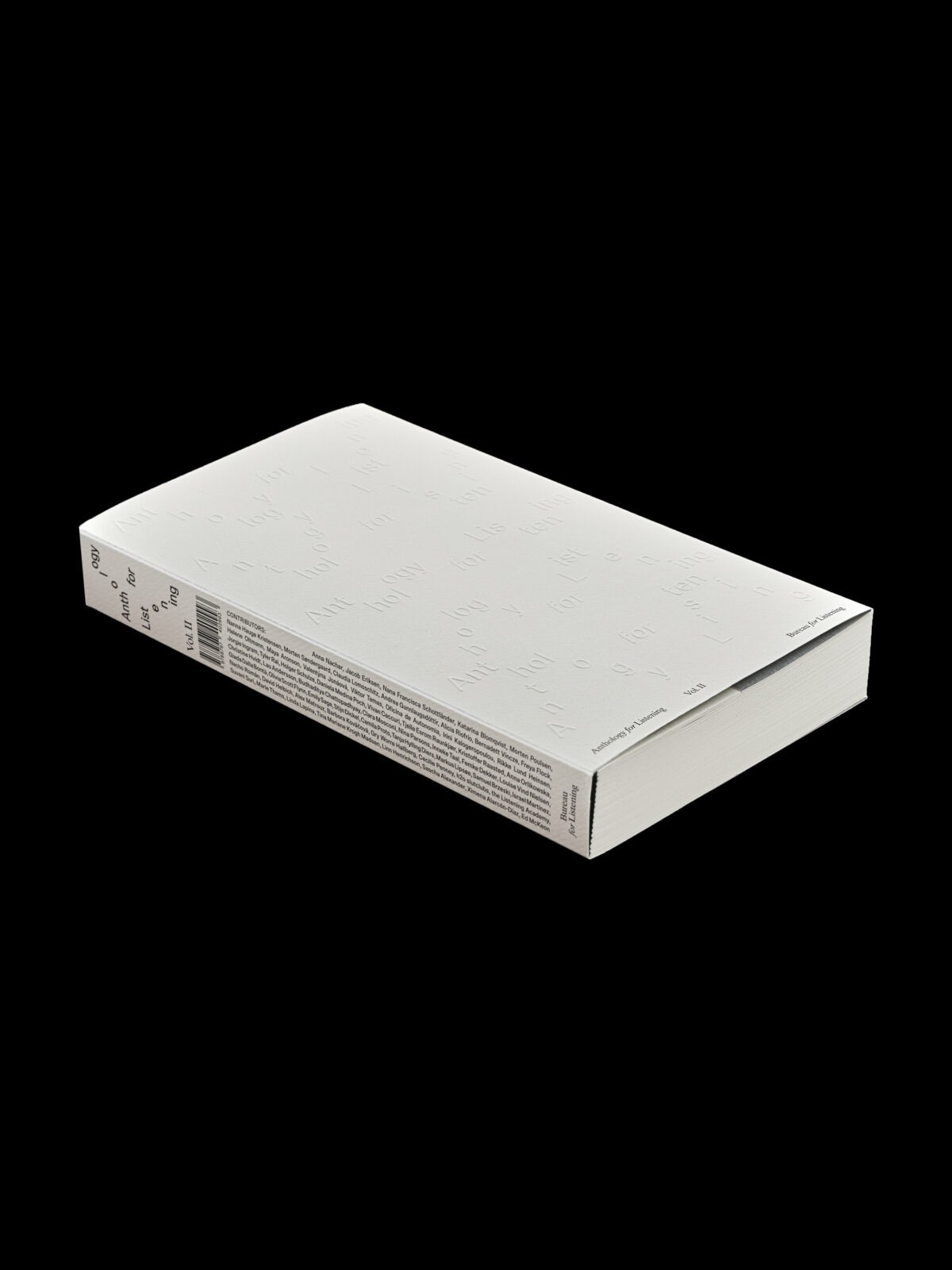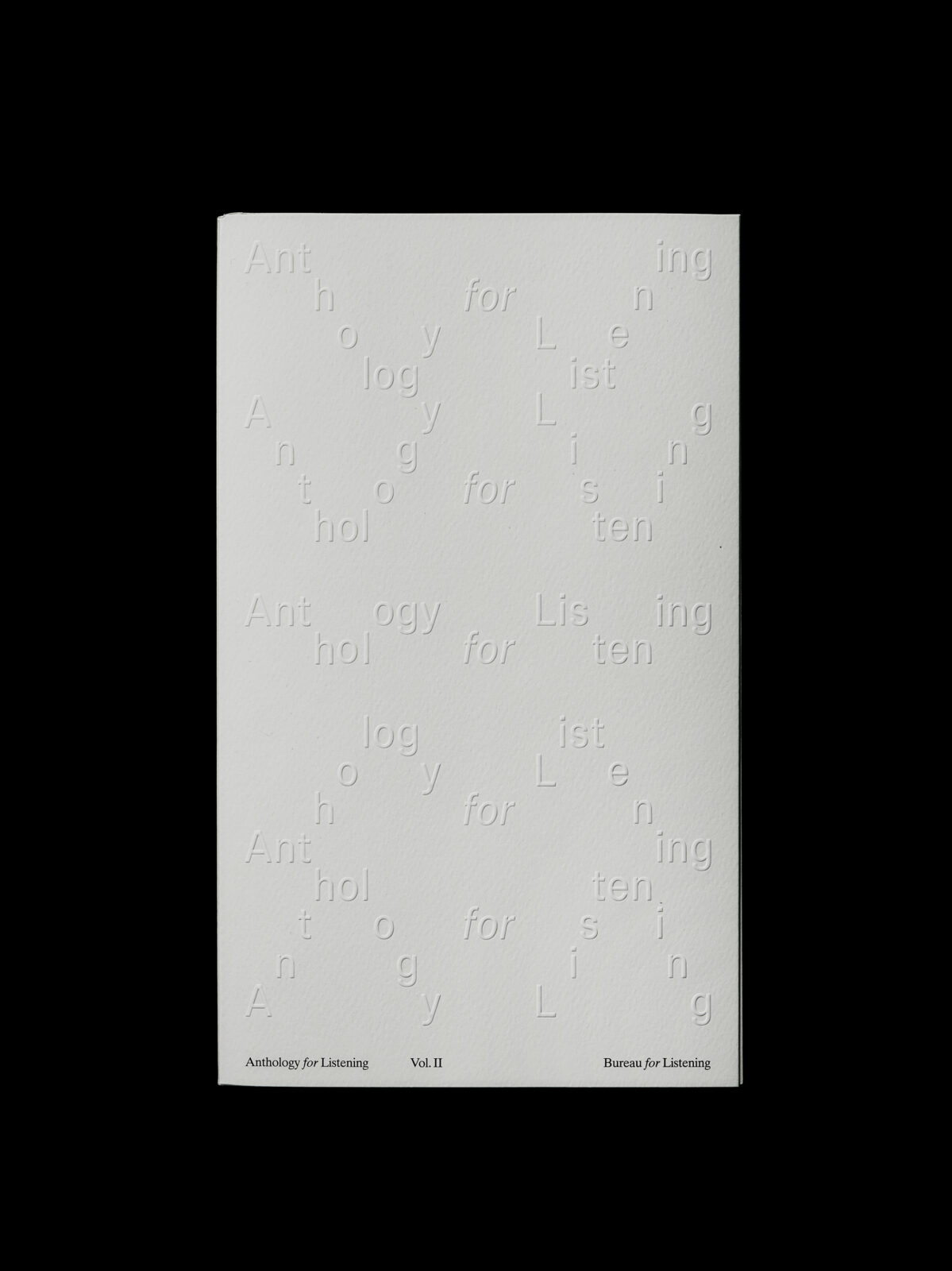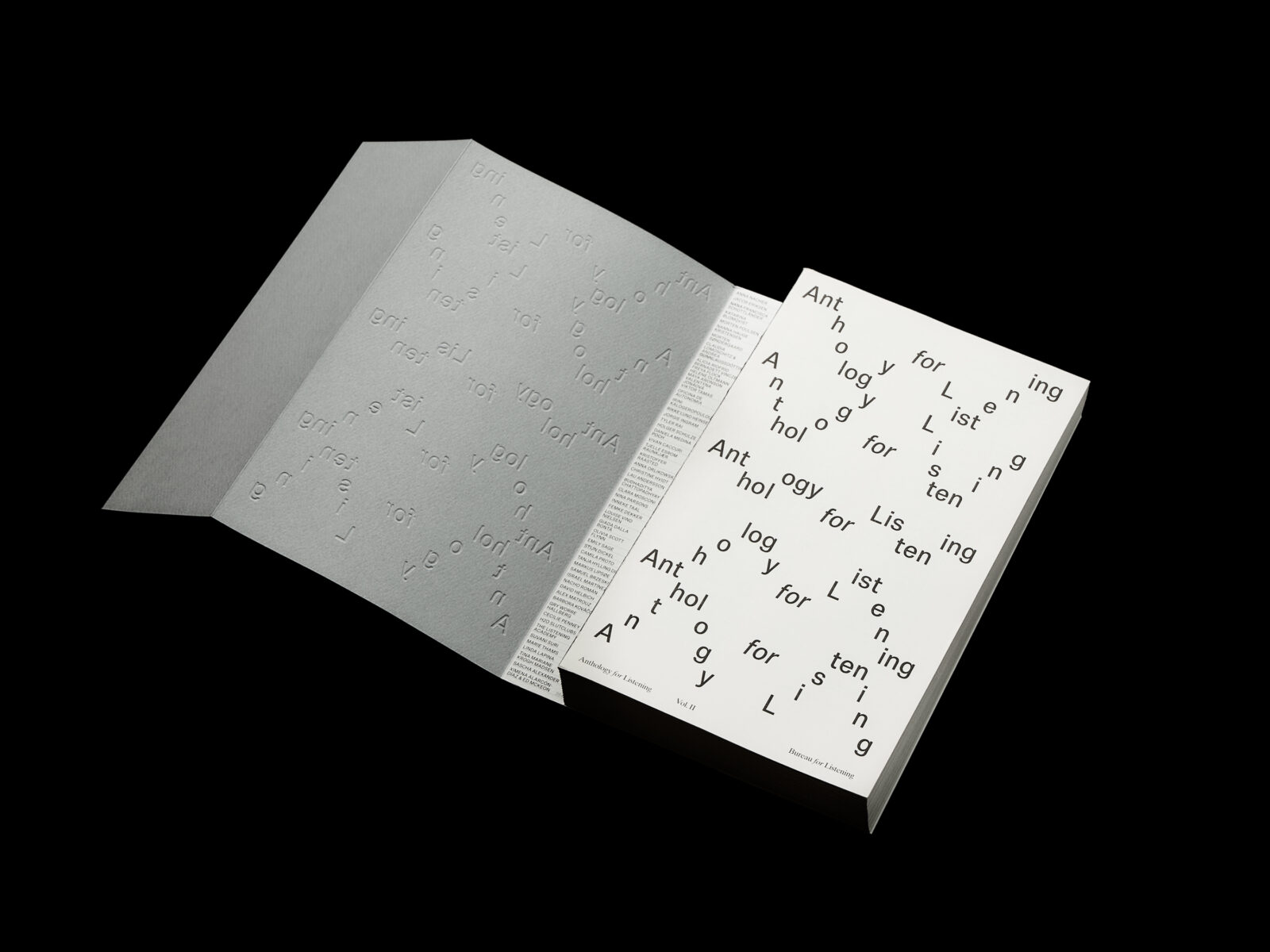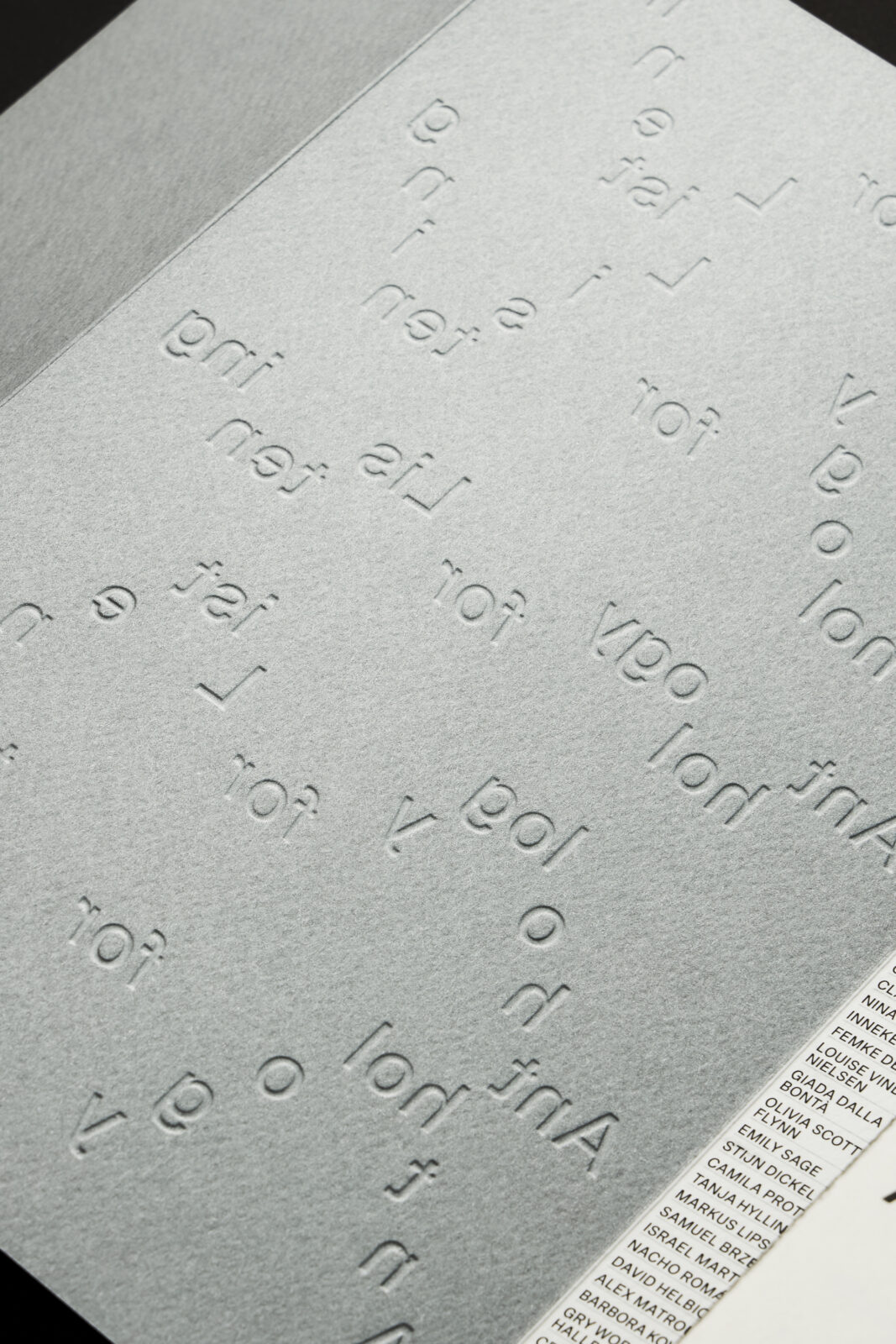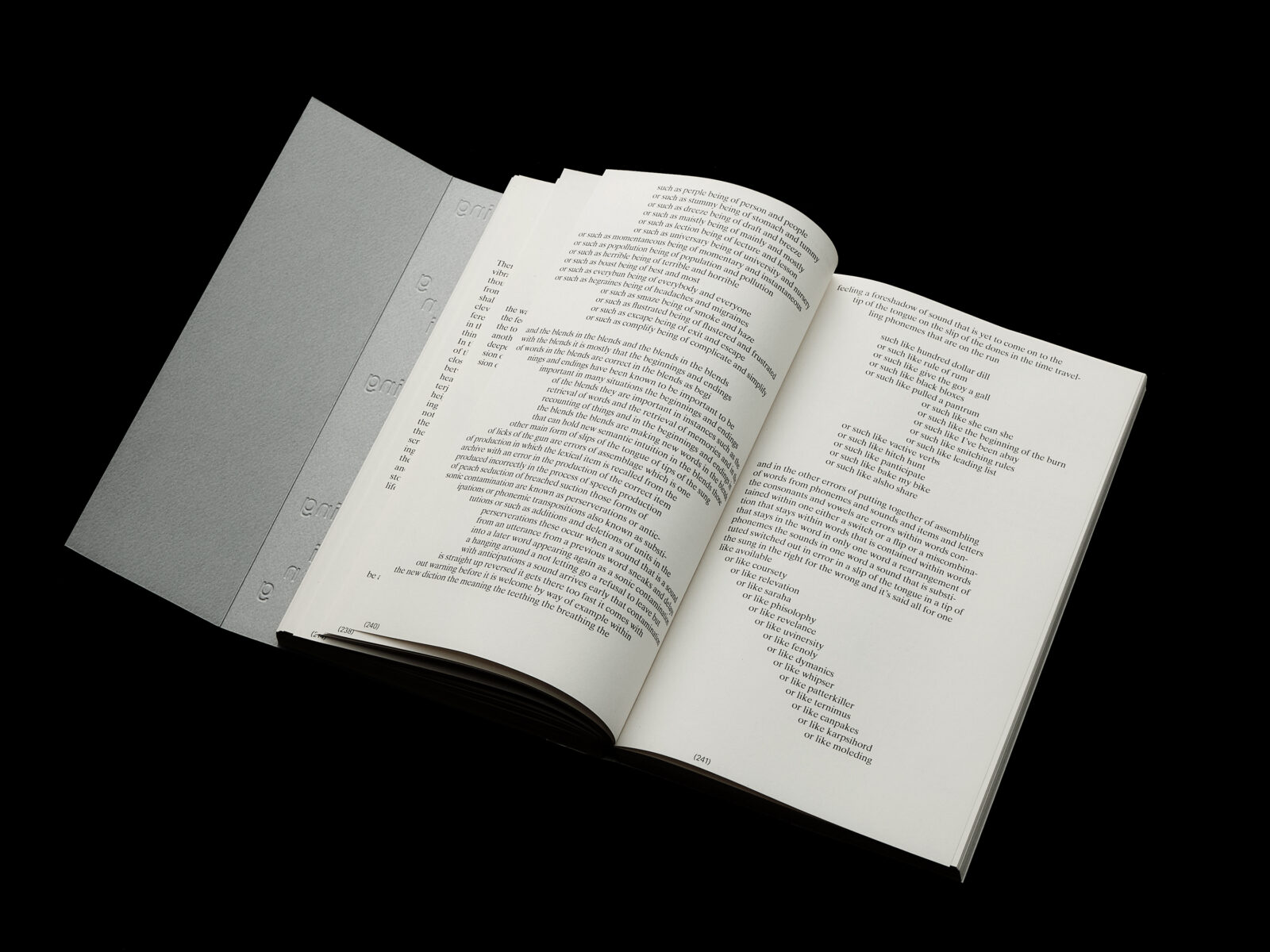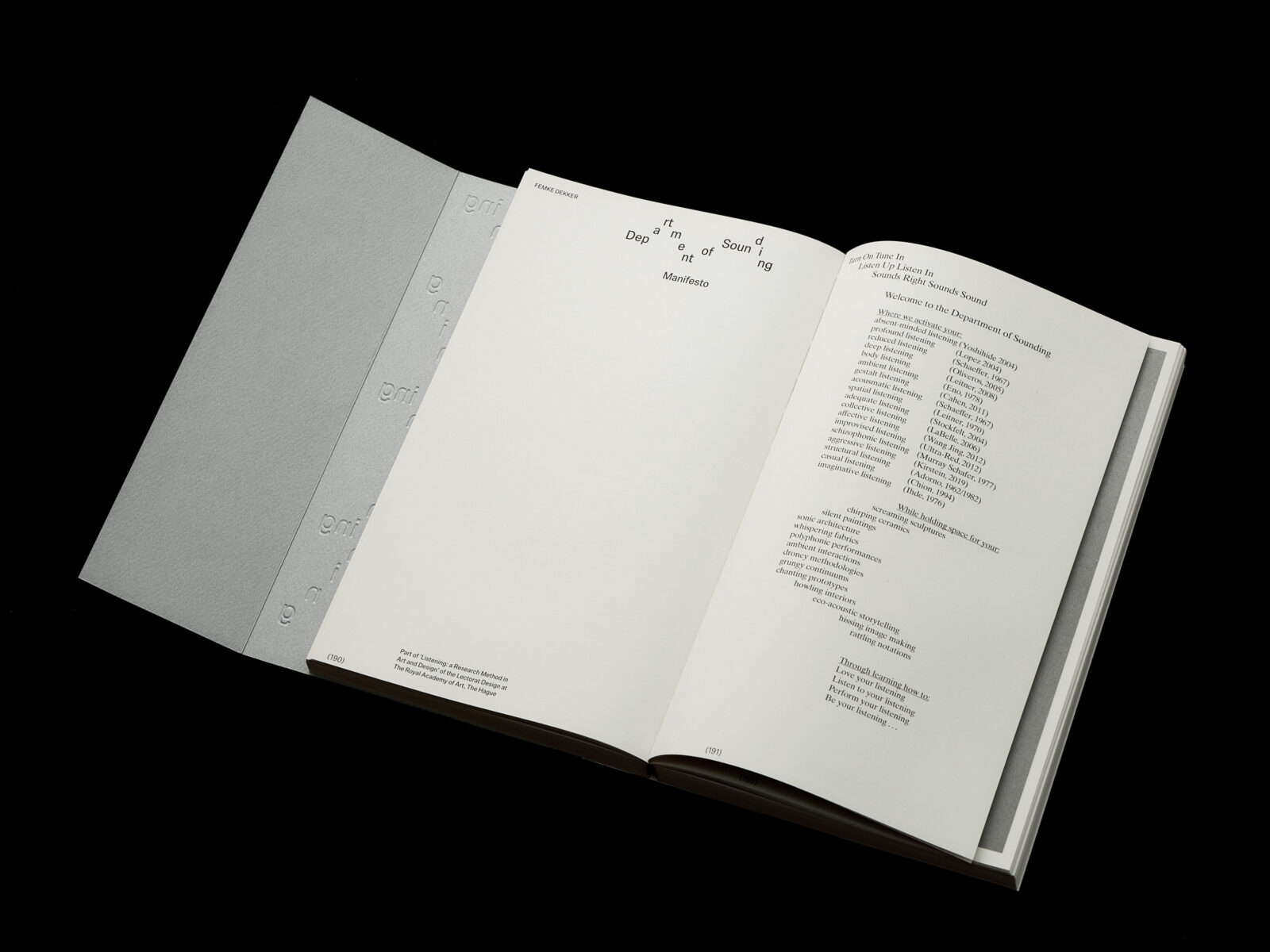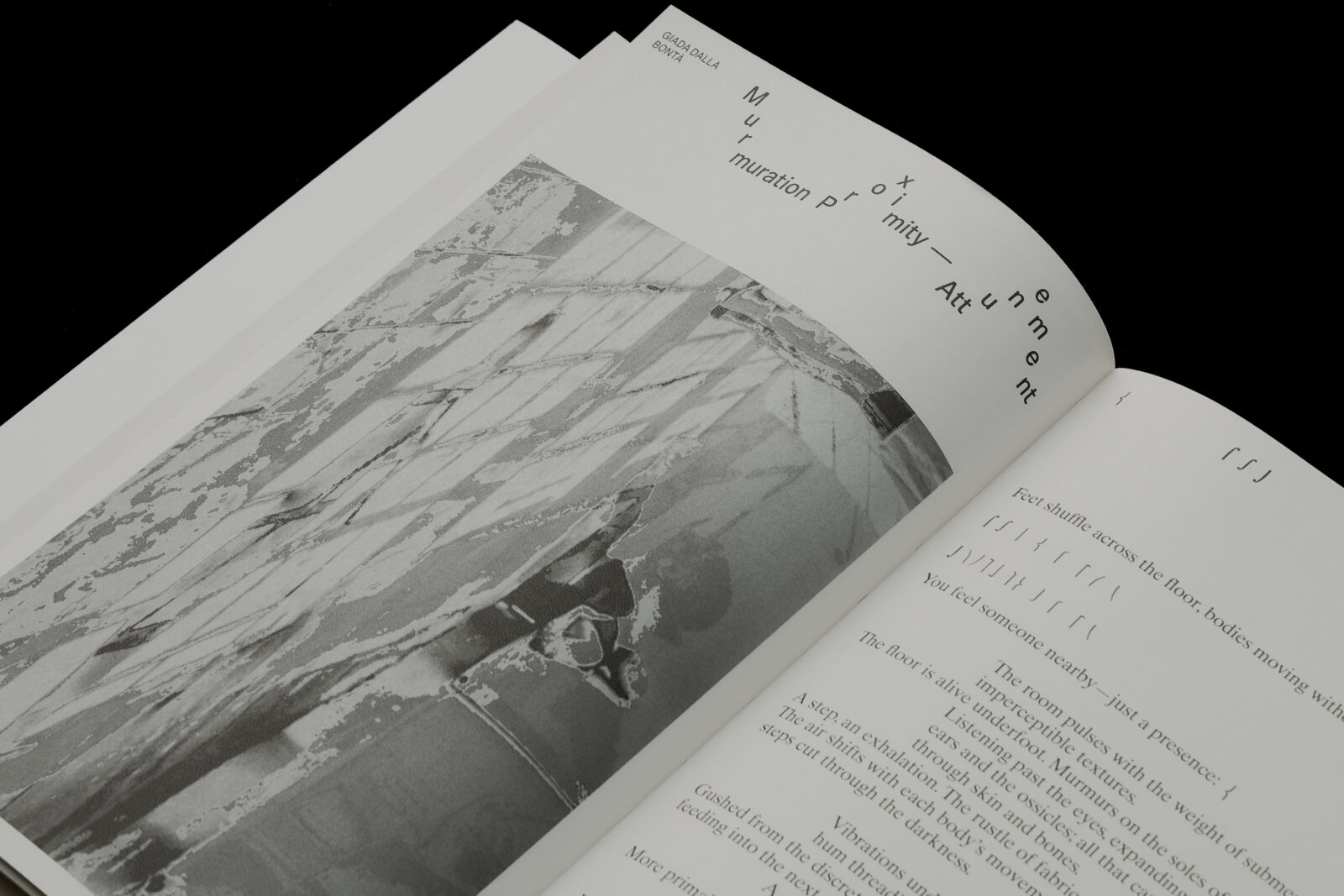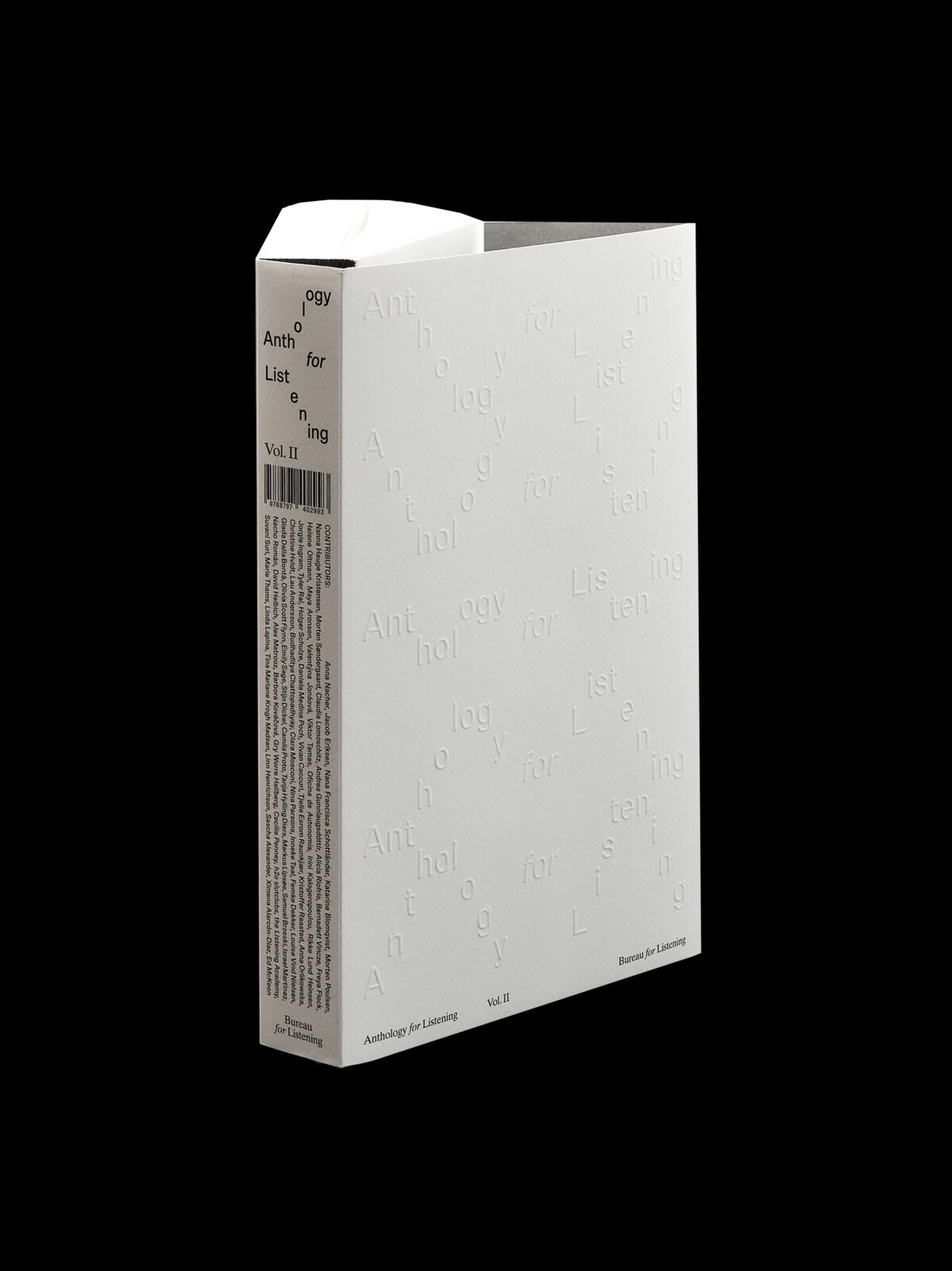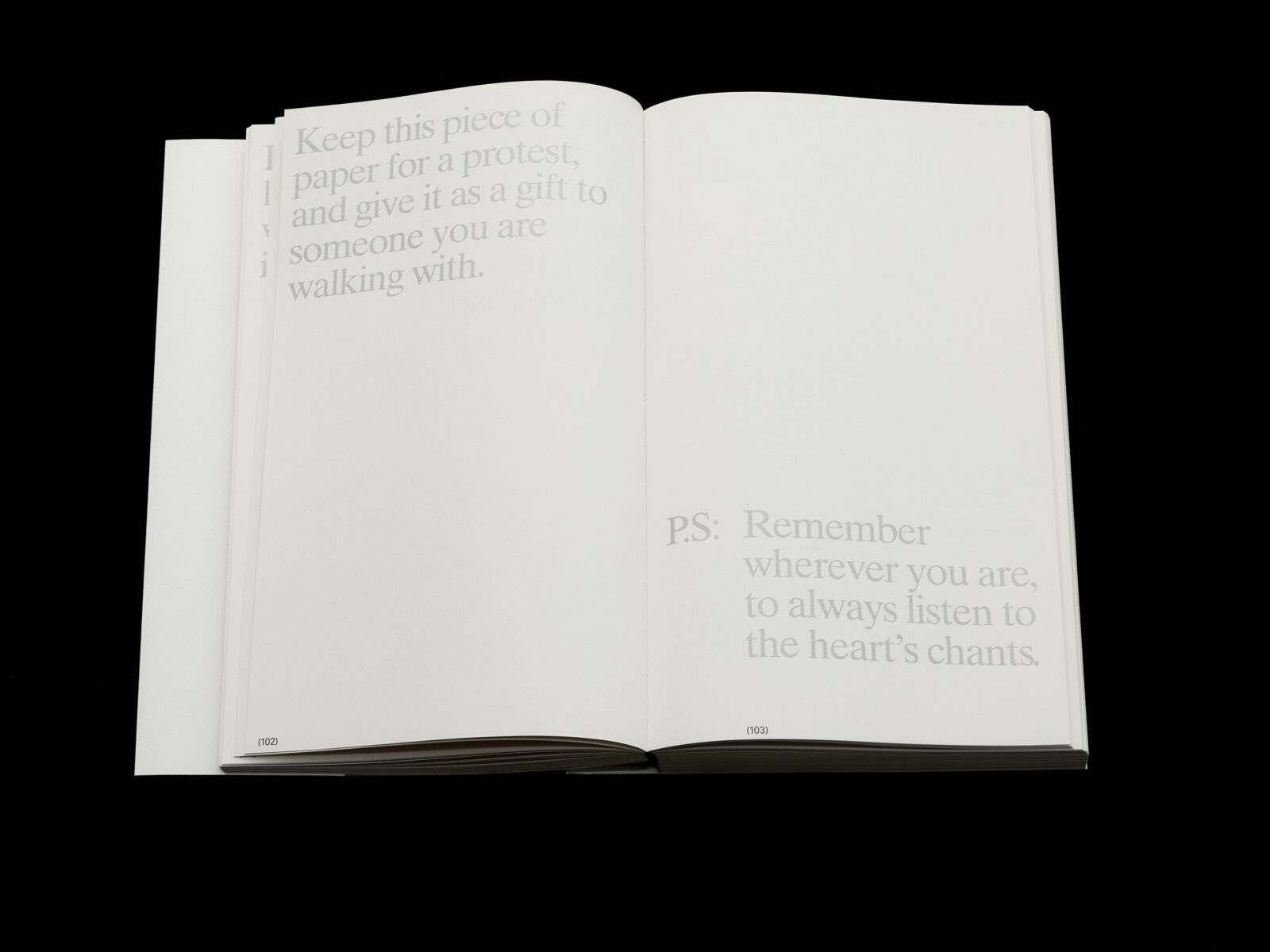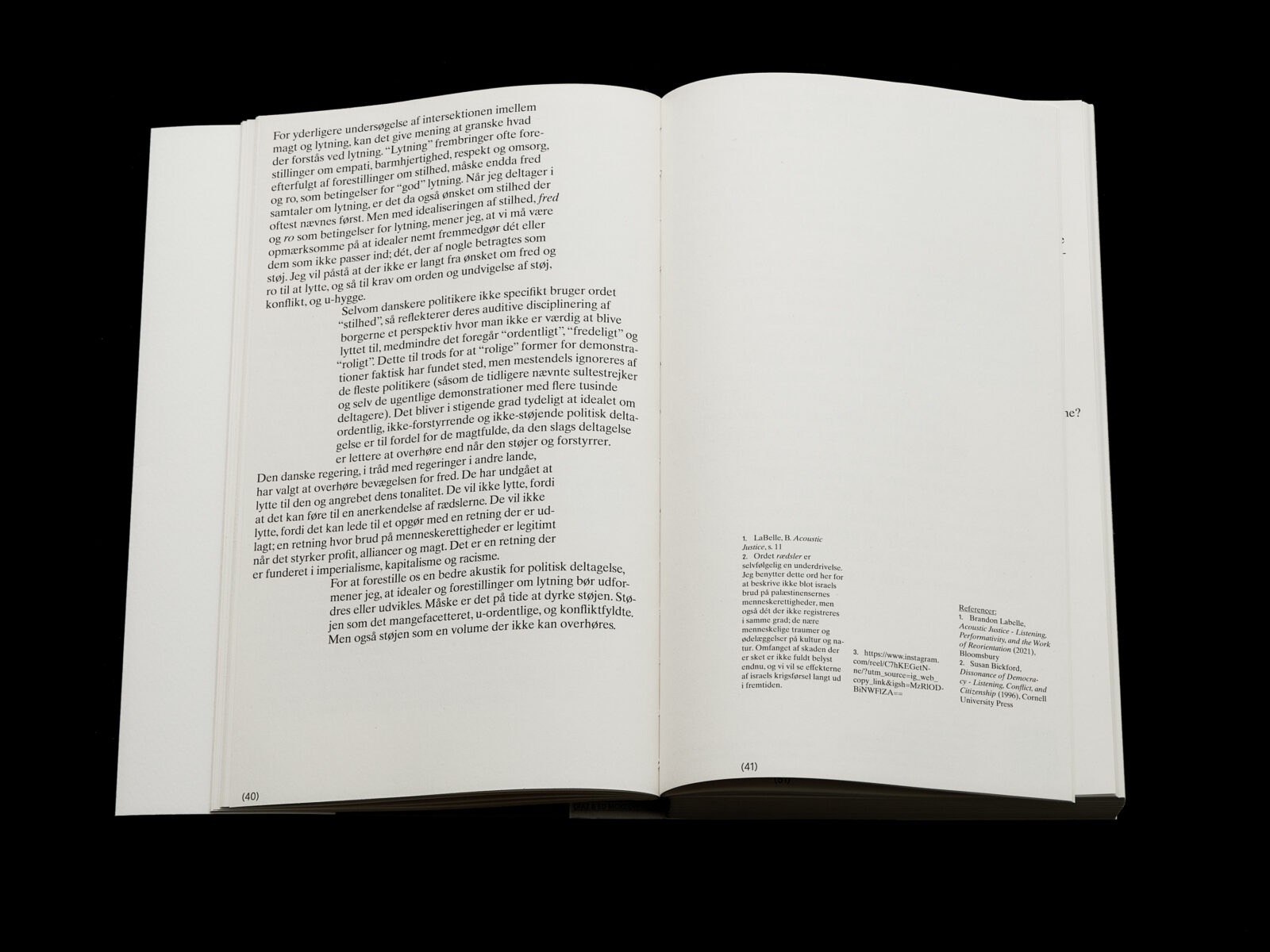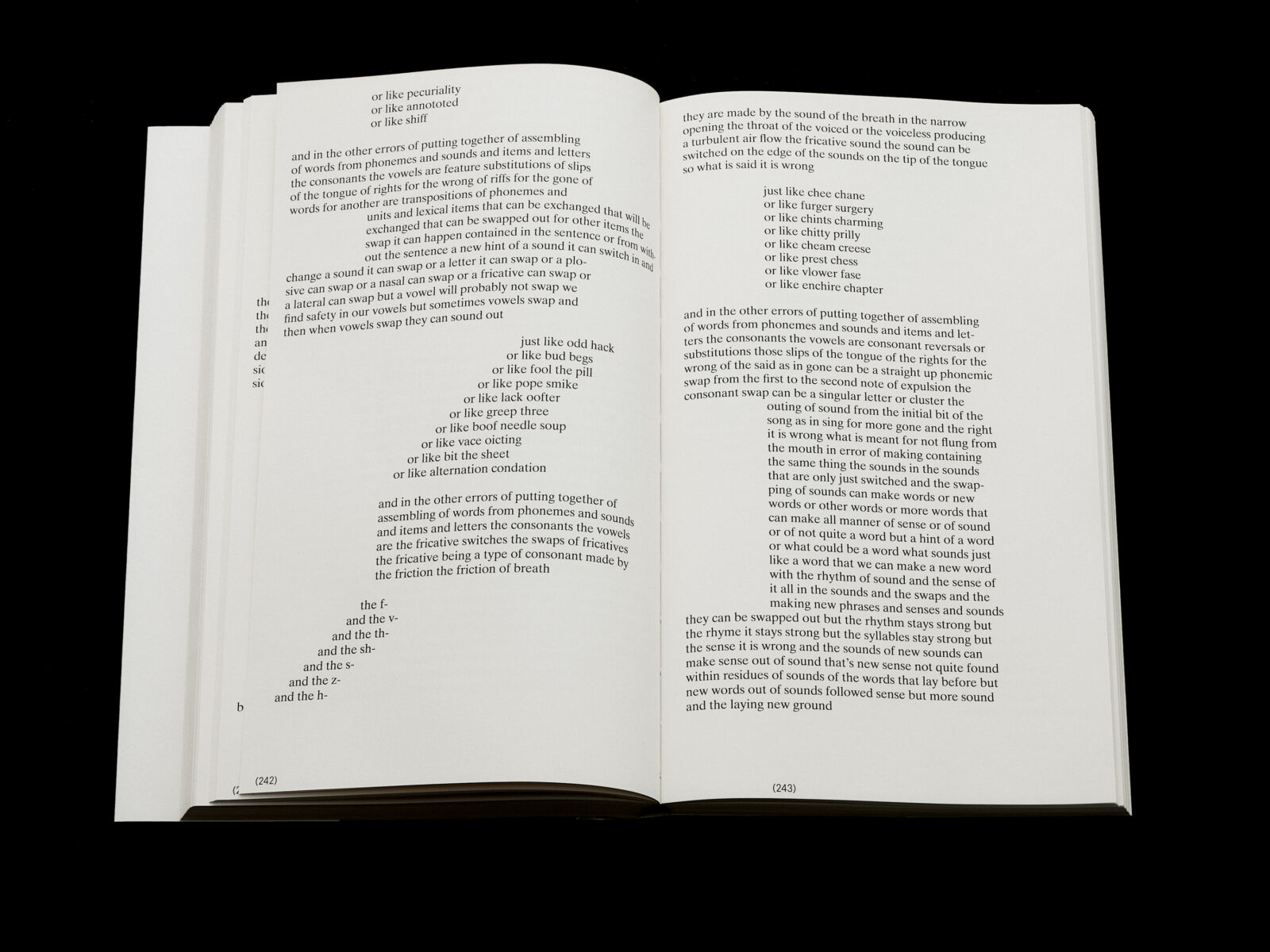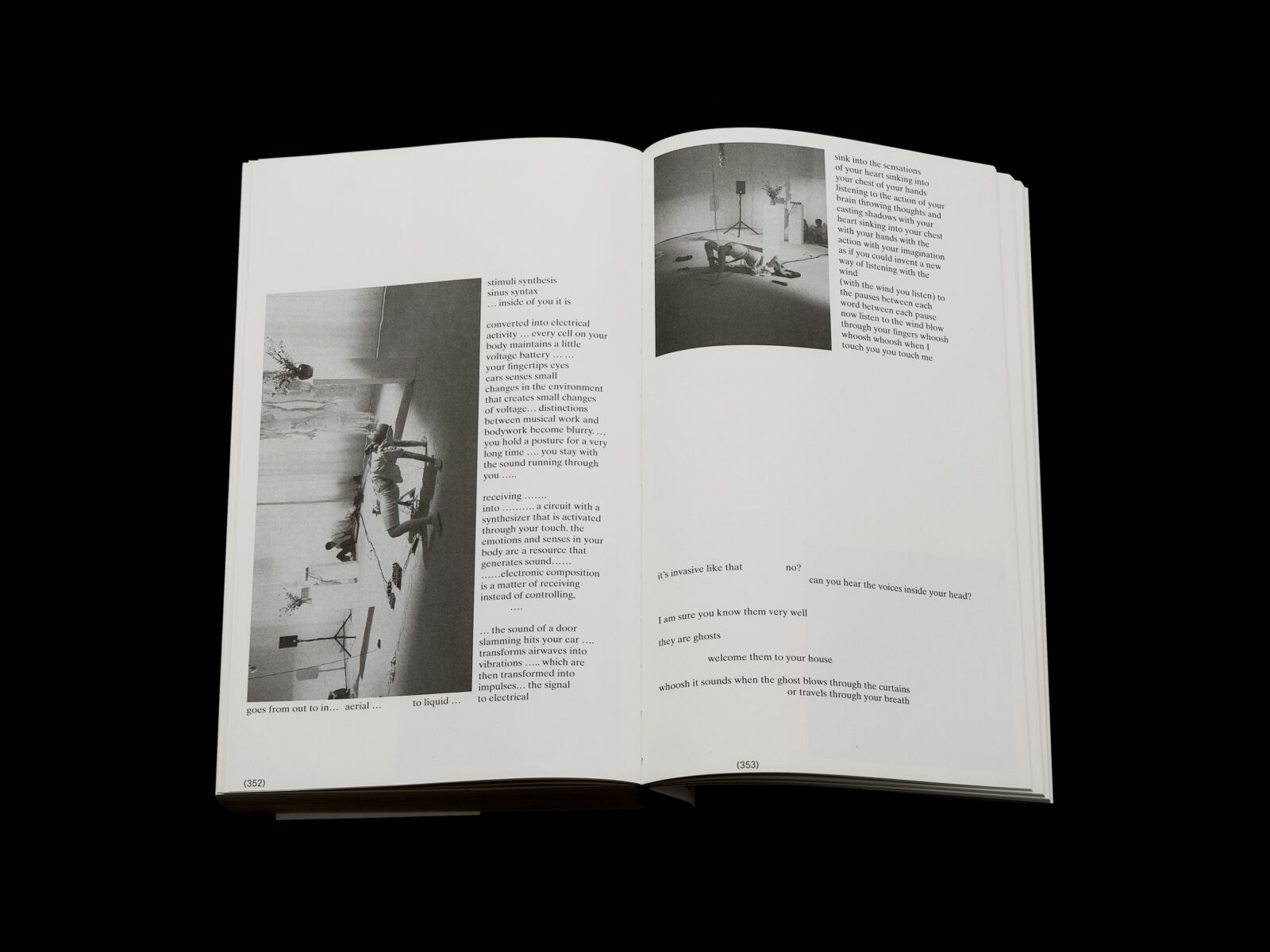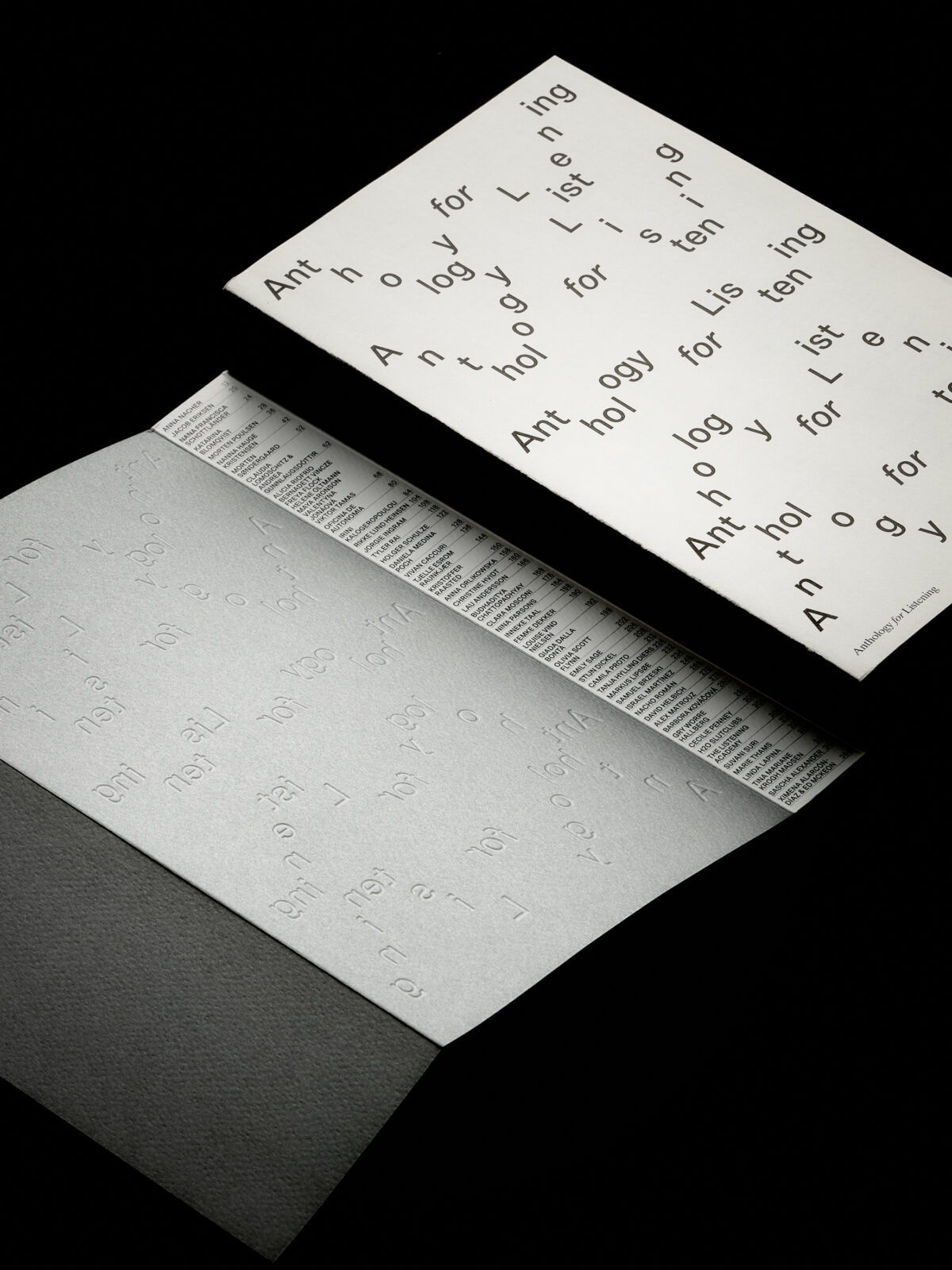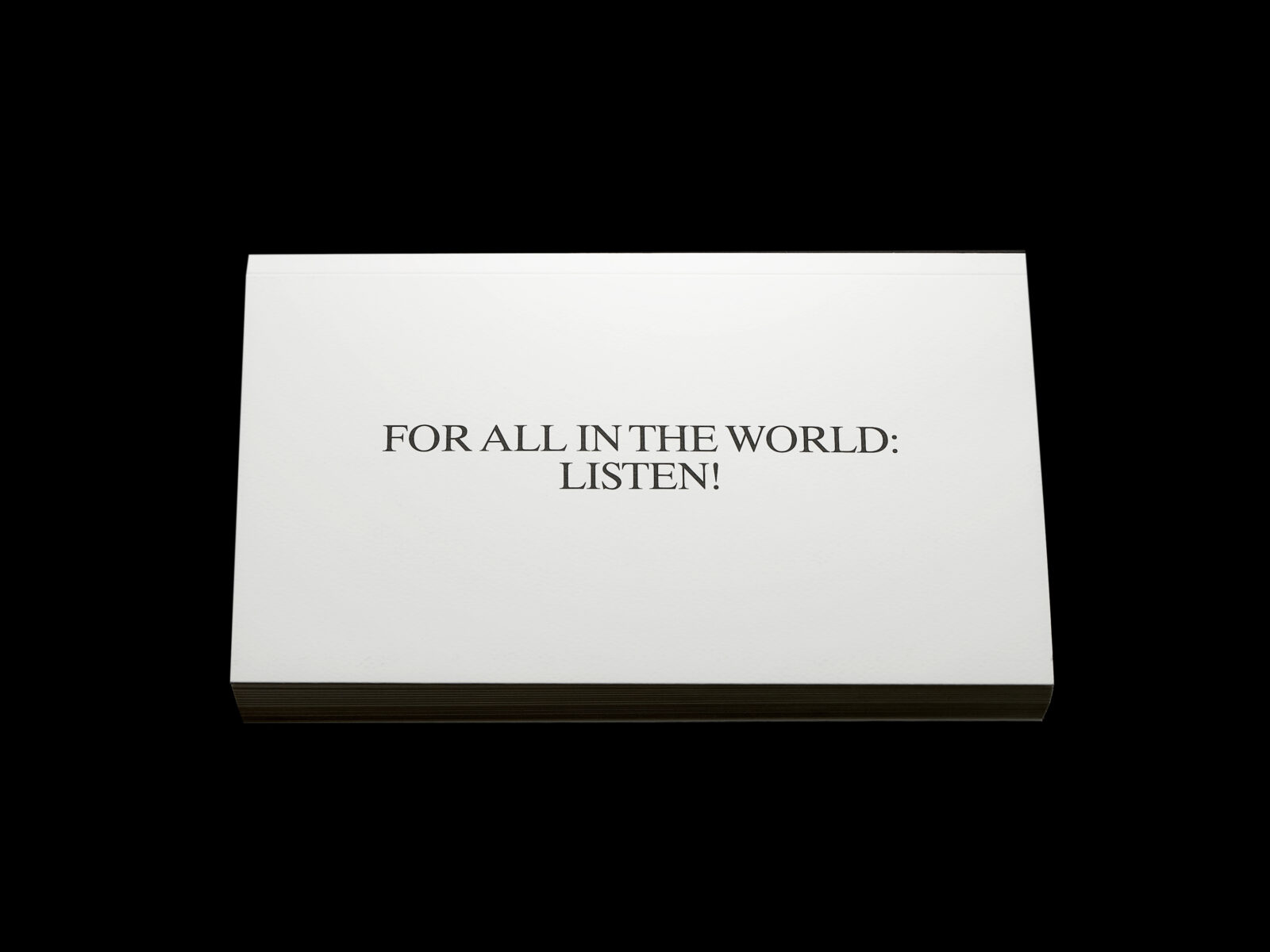Anthology for Listening Vol. II
Anthology for Listening Vol. II
2024
—
[Read the press release here] // [Access the printed version as a pdf here]
—
Explore: Anthology for Listening Vol. II // LAUNCHES
—
Explore: Anthology for Listening Vol. II // Live-version I (KoncertKirken, Copenhagen)
—
Prologue: Invitation to the Anthology for Listening
Dearest fellow listener
This invitation is intended as a small gesture of support and nurturing for the multiple, slow, quiet, as well as the loud, complex, and struggling voices, encounters and experience you might listen to and within this material.
–
Take your time to arrive.
All of you are welcome here.
–
When engaging with this anthology, please consider its agency; its temperament and what it calls for. It may ask you to be gentle. It may ask you to be rough. Find comfort in being with it.
We ask for your help to welcome and host the listening taking place within this material. The anthology is a collective being, existing in a complex time-space. It has traveled across distances, heritages, and through experiences no single individual could embody alone, and we invite you to engage with it caringly.
–
We ask you to take a moment. To not rush when moving through the contributions.
Sense the possible shifts in attention and input now that you have been with the anthology for a while.
Rest with it. Listen with it.
–
As we invite you in, we also thank you for listening; for holding and engaging in a space for different voices, unknown and known histories, for the said as well as unsaid, and unsayable, for the changes being present and still to come, for the not-yetness, the risks and vulnerabilities, and endless (re)generative imaginations and associations. We thank you for engaging listening as not only a critical and artistic practice, but also as a way of life, a way of meeting others, of engaging deep pulses and intimate moments of becoming-with. We thank you for holding as well as sharing fragility as well as strength.
Just as listening can be beautiful, a force for good, gentle and offer love, it may also come to one as hurtful and weaponized; through specific noises or words to which one is unprotected, as unbearable and invasive of one’s most fundamental core through the unlistenable cries of others, or by the consequences of not listening, not being listened to.
Listening is complex, and perhaps we can only be ignorant of its complexity, while still feeling drawn and pulled by its gravity. We thank you for your courage to continue listening; and to continue listening differently.
–
We invite you to embrace how, as you listen, read and take in, you are also listened to.
No engagement with the material is the same.
–
Yours sincerely
Bureau for Listening
Introduction: Notes for Anthology for Listening
Bureau for Listening
—
An Echo of Moria
Nanna Hauge Kristensen
—
Collection of Questions and Seven Ways of Listening – A Research Extract
Alicia Riofrío, Bernadett Vincze, Freya Flock, Helene Oltmann, Maya Aronson, Valentýna Jonáová, Viktor Tamas
—
UNTAMED LISTENING: Reflections on the Undomestication of our Listening Practices
Daniela Medina Poch and some nettles of Berlin
—
Epilogue: Acknowledgement
Drafted by Bureau for Listening, edited collectively with all contributors
—
Contributors:
Alex Matrouz. 1989. He/him. Morocco.
Alex Matrouz is a musician and performer, often taking to the streets and other non-institutionalized spaces to create and live. He is hesitating to offer more information.
To listen is to digest.
Alicia Riofrío, Bernadett Vincze, Freya Flock, Helene Oltmann, Maya Aronson, Valentýna Jonáová, Viktor Tamas.
We are humanities students from Roskilde University. Throughout our last semester project on listening, we individually and collectively realized the vast possibilities this practice offers when we attune to our bodies, each other, and our surroundings with care.
To listen is an awareness, a radical yet soft form of resistance.
Anna Nacher. 1971. She/her. Poland.
As a listener and sound practitioner I am interested in interstices and zones of in-betweenness, and transformations occurring between elements (especially water and air). I’m associate professor of digital culture and media theory and an avid permaculture practitioner.
To listen is to be present with whatever is emerging from moment to moment and to be courageous enough to hold space for it.
Anna Orlikowska. She/her. Poland/Netherlands.
Anna Orlikowska is a Warsaw-born artist based in Amsterdam. Her site-related work includes installation, performance, sculpture, video, drawing, text, and sound. She received her MFA from the School of the Art Institute of Chicago as a New Artist Society Fellow.
To listen is to recognize the shifting lines between the animated and the inanimate.
Attunement Board (Bureau for Listening).
Rather than an advisory board, Bureau for Listening is supported by an Attunement Board, with current members including performance artist Gry Worre Hallberg, Prof. Holger Schulze, artist Nana Francisca Schottländer, and poet Morten Søndergaard. You can read more, including a ‘Declaration of Attunement‘.
To listen is to attempt and stay curious to the practice of attunement.
Barbora Kováčová. 1990. Slovakia.
[intentionally blank]
To listen is to be present.
Budhaditya Chattopadhyay. He/They. The Netherlands/India.
Budhaditya Chattopadhyay is an artist, researcher, writer, and theorist. Working across diverse media and incorporating creative technologies, Chattopadhyay produces exhibitions, installations, and live performances addressing issues of ecology and environmental justice, migration, race, and decoloniality.
To listen is to give patient and empathic attention.
Camila Proto. 1996. She/her. Brazil.
Camila Proto is an artist and researcher exploring storytelling through multimedia installations, film-essays, and texts. She holds a Master’s in Visual Arts and is currently pursuing a PhD at the Federal University of Rio de Janeiro.
To listen is to be open to what the world has to say.
Cecilie Penney. 1990. She/her. Denmark
Cecilie Penney is a visual artist and electronic music composer primarily working in digital media, video, sound, text, and installation. Drawing on (post)digital aesthetics, her practice examines social, linguistic and technological systems in society.
To listen is to give attention to a single thing or several things (at the same time).
Christine Hvidt. 1989. She/they. Denmark.
Christine Hvidt is a multidisciplinary artist exploring symbiotic practices between people and planetary creatures, currently relating to farmlands through algorithmic organisms, listening and sound. She holds a MA from Artscience Interfaculty (NL), and a BA in Art and Technology (DK).
To listen is to lend your attention and time to grow generosity.
Clara Mosconi. 1995. She/her. Denmark/Italy.
Clara Mosconi is an artist exploring voice, language, and bilinguality. Her work with paralinguistics stems from slowly losing her second language, Italian, prompting her to focus on creating relationships beyond rational language, and methodologies aimed at challenging the position of the linguistic outsider.
To listen is an interactivity, which produces and invents that which is heard and strengthens our worldly contact. It is unfolding the present moment and the opposite of the desired objectivity in the act of seeing.
Claudia Lomoschitz. 1987. She/her. Austria/Denmark & Andrea Gunnlaugsdóttir. 1988. She/her. Iceland/Austria.
Claudia Lomoschitz is a visual artist combining video, text, and performance to create tactile, counter-normative spatial settings. She studied at the Academy of Fine Arts Vienna, where she works as lecturer, graduated her MA in Performance Studies at the University of Hamburg and studied at the Royal Danish Academy of Copenhagen.
Andrea Gunnlaugsdóttir is a dancer/choreographer/performer. Her works move between dance, performance and visual arts and often seek out formats beyond the stage. Andrea studied at the Salzburg Experimental Academy of Dance where she graduated with a major in choreography in 2014.
To listen is to attune attentively to one’s perception.
Daniela Medina Poch. 1992. She/her. Colombia.
Daniela Medina Poch, based in Bogotá-Berlin, explores ecological discourses through expanded listening and critical examination, challenging their universality and hierarchies. Her work spans research, performance, and everyday gestures, and is featured internationally.
To listen is an attempt to deborder and de-other.
David Helbich. 1973. He/him. Belgium/Germany.
David Helbich (Berlin/Bremen/Brussels) is a composing sound, installation, visual, and performance artist who creates inter- and intro-active works for the stage, headphones, paper, and online media and in public space.
To Listen is to perform.
Ximena Alarcón. & Ed McKeon. 1972. He/him. The United Kingdom.
Dr. Ximena Alarcón is a sound artist-researcher exploring sonic migrations and the resonances between borders we cross when listening. She creates telematic improvisations and interfaces for relational listening. She is a Deep Listening® tutor and holds a PhD in Music Technology.
Ed McKeon is a musician who neither performs nor composes, working at the intersections of music, theatre, installation, and performance. He has collaborated with artists from Pauline Oliveros to Heiner Goebbels and Shiva Feshareki to Brian Eno. He is a Postdoctoral Fellow at Birmingham City University.
To listen is to be plural.
A Listener. – . – / – .
A pseudonym.
To listen is a refined time wasting practice.
Emily Sage Avery. 1994. She/her. United States of America.
Emily Sage is a US-based sound artist with strong leanings in jazz, soul, and cinema. Her work is heavily influenced by her time growing up in Portugal, which has shaped her romantic and melancholic songwriting style. Sage’s creative practice is built on a foundation of innovation and emotional honesty. Her work finds new ways to communicate and express the complexities of what it means to be alive, diving deep into moments that feel fundamentally human.
To listen is to open the door to connection with the world, with an other, and with self.
Femke Dekker. Artist name Loma Doom. 1973. The Netherlands.
As a sound-practitioner the core of my practice – both as an artist and as an educator – revolves around listening. In my sonic practice I seek outliers. It is a practice that avoids linearity, that goes towards a space where intuition and understanding meet through improvisation.
To listen is to tune into the potential of change.
Giada Dalla Bontà. 1986. She/her. Italy, Germany, Denmark.
Italian researcher, curator and writer focusing on the intersection between sound, politics, art, underground and experimental practices. Based in Berlin and Copenhagen, she is a PhD fellow at the Sound Studies Lab, University of Copenhagen.
To listen is to be.
Gry Worre Hallberg. 180876. She/her/hers. Denmark.
Gry is the co-founder and artistic director of the performance group and movement Sisters Hope. She argues for the necessity of practices and spaces for aesthetic inhabitation in order to transition into a more sustainable future. Her PhD is published by Ethics International Press as Inhabitation – A New Artistic Paradigm at the Intersection of Aesthetics and Ecology.
To listen is to travel deep.
h2o slutclub – Frederikke Krebs Bahn and Marie Flarup Kristensen. 1995/1992. She/her. Denmark.
h2o slutclub is a music-performance-business-collective. Our sleepy universe uses rest and yawning as resistance to good old capitalism. Dressed in corporate feathers, we may look like a bunch of hardworking employees, but instead of creating financial profit, we cuddle and send cute text messages to each other. We hire aaaaaaaall the time and are therefore a fluid and agile crew. Sometimes BIG, sometimes small. Join our live-music-business-meeting and don’t forget to bring your business cards. Partner with us and make some hay!
To listen is a hard job.
Holger Schulze. 1970. He/him. Denmark/Germany.
Holger Schulze is professor in musicology at the University of Copenhagen and principal investigator at the Sound Studies Lab. Publications: The Bloomsbury Handbook of the Anthropology of Sound (2021), Sonic Fiction (2021), The Sonic Persona (2018).
To listen is always different.
Inneke Taal. 1985. She/her. Australia/Netherlands.
Inneke Taal’s sculptural practice combines multi-media installation and performance to explore embodied experiences and spatial relationships. She disrupts traditional presentations, questioning time and narrative using found objects, moving image, text, sound, and the body.
To listen is to feel the shape of something; to listen to its echo in space.
Irini Kalogeropoulou. 1998. She/her. Greece.
I’m Irini Kalogeropoulou, an interdisciplinary artist, researcher, and arts educator based in Athens, Greece. My work focuses on sound art and participatory practices in public space, exploring themes of grief, absence, memory, urban dynamics, and the nuances of everyday life.
To listen is a form of poetry in action.
Israel Martínez. 1979. He/him. Mexico.
Israel Martínez works from sound to the visual arts, often with influences from literature, creating works and projects materialized in multichannel audio installations, video, photography, actions and text, trying to generate critical social reflections and to explore some aesthetic and political possibilities of silence.
To listen is opening a necessary pause.
Jacob Eriksen. 1985. He/him. Denmark.
Jacob Eriksen is an artist, curator, researcher. Director of Sound Art Lab and Struer Tracks, lecturer at Sound Studies and Sonic Arts at UdK Berlin. Focuses on artistic engagement through sound and listening as drivers for artistic expression and knowledge production.
To listen is to be actively open toward the others.
Jorgie Ingram. 2000. She/her. United States of America.
Jorgie Ingram uses movement, imagination, and sensing to facilitate an expansion of what we believe to be possible of us and the space around us. We imagine and create tangible environments that support us; with emphasis in somatic practice and mindfulness, Jorgie enacts this through dance research and performance, choreography, writing, multimedia art-making practices, creative consultation, and project management.
To listen is to expand time and possibility.
Katarina Blomqvist. 1969. She/her. Finland.
Katarina Blomqvist is an audio documentary director and artist-researcher at the Department of Film, Aalto University School of Arts, Design and Architecture, Finland. With an MA in Philosophy, she explores listening as both an artistic and philosophical practice in her documentary audio art.
To listen is to aspire to an attentive attunement and ethical engagement with another person.
Kristoffer Raasted. 1988. He/him. Denmark.
Kristoffer Raasted is a visual artist focused on sound. Educated at the Royal Danish Academy of Fine Arts, he is pursuing a practice-based Ph.D. His work explores voice studies and queer theory through singing, DJing, broadcasting, and writing.
To listen is part of vocalizing.
Lau Andersson. 1999. He/Him. Denmark
Composer.
To listen is to surrender.
Linda Lapiņa. 1985. She/they/it. Latvia/Denmark.
I am a knowledge worker and a mover. Listening is at the heart of both practices. I work as an associate professor of Cultural Encounters at Roskilde University, where I aim to co-create spaces for a plurality of ways of knowing.
To listen is to be in touch.
Louise Vind Nielsen. 1984. Mixed. Born in Denmark, based in Hamburg.
Louise Vind Nielsen is a Danish artist based in Hamburg. Her work explores the mystery of how we listen and perceive our surroundings, as well as the interrelations between humans, other creatures and machines. In a diverse artistic practice that combines sound, performance and image with elements of mythology, psychology and social engagement, she seeks to explore complex themes with an obscure and humorous approach.
To listen is an attempt to find orientation and connection with ourselves, our surroundings, and other creatures in the daily moshpit we are immersed in.
Marie Thams. 1982. She/her. Denmark.
Marie Thams is a visual artist working in installation, sculpture, sound, film, poetry and performance. She is educated at Schools of Visual Arts, Royal Danish Academy of Fine Arts, Copenhagen and Goldsmiths, London. Her work is part of Danish National Gallery’s and Aalborg Municipality’s Art Foundation’s collections.
To listen is to tune into the world, to stay porous and in movement.
Markus Lipsøe. He/him. Denmark.
My work asks, what is or what could be happening at any given moment. To look at the world as itself being a maker of art, and our role being to simply notice. To find, figure out and share the tools that make this happen.
To listen is to receive knowledge without talking about the things of this world, how they exist, how they are — how you can’t refuse them.
Morten Poulsen. 1990. He/him. Denmark.
Artist Morten Poulsen explores how we are embedded in socio-political structures, focusing on gender, power relations, and the environment. Central to his work is the idea of listening as a transformative activity with the potential to (re)form the listener(s).
To listen is an intangible, intersubjective and transformative activity; it’s about attunement and entanglements, about coming together and being together; the auditory is a space we share, and carries with it a responsibility for understandings of subjectivities, privileges and limitations. In such spaces, listening is an economy of attention-giving-and-taking which prompts us to consider what and who is not being heard and what re-hearing might do to our self-understandings
Morten Søndergaard. 1966. Denmark.
MS is a curator and associate professor of media art and sound art at Aalborg University, Denmark. MS generally works with media and sound in transdisciplinary, constructive, critical and creative maker settings and developing theory and ideas from those settings.
To listen is to listen is to listen…
Nacho Román. 1976. Spain.
Nacho Román is a sound artist working in experimental electronics, field recordings, and ambient music, blending organic and synthetic elements. A founding member of the Néxodos Contemporary Art Collective, and coordinator of the Vestíbulo label.
To listen is one the most profound experiences for a human being.
Nana Francisca Schottländer. 1977. She/they. Denmark.
Transdisciplinary artist working in the intersection between performance, choreography and installation exploring co-creational potentials and intimate encounters between human and more-than-human worlds and bodies.
To listen is to stay open to the questions rather than answering them.
Nanna Hauge Kristensen. 1980. She/her. Denmark.
Nanna’s work moves in the intersection of audio documentary, art, and anthropology. What attracts her, both as a creator and as a listener, are intimate, sensory and open-ended explorations. Her audio pieces have been broadcasted on BBC3, BBC4, Danish Radio and so on, and have been honored with several international awards.
To listen is to be intimate with existence.
Nina Parsons. 1991. She/her. Denmark.
Nina Parsons is a visual artist who works primarily within photography and moving image. With her work, she strives to create a visual narrative that is bound by documented memories and fictional scenarios, thereby creating a bridge between what is factual and what is not.
To listen is to pause.
Oficina de Autonomia.
Oficina de Autonomia is a loose collective of artists, performers, writers and musicians, focusing on practices of voice, locality and social transformation.
To listen is waiting.
Olivia Scott Flynn. 1994. She/they. United States/Denmark.
Olivia is a multidisciplinary artist, designer, and researcher using design and storytelling for social change. With a queer, feminist perspective, her work spans spatial design, food systems, and community co-creation, focusing on equity and lived experiences. Based in Copenhagen, she also has roots in Brooklyn and Michigan.
To listen is to witness, with no agenda and abundant curiosity.
Rikke Lund Heinsen. 1967. She/her. Denmark.
I am a researcher, a teacher, a performing art person, a pedagogue. For many years, my main interest and work has been situated around young students at the National Danish School of Performing Arts and the Rhythmic Music Conservatoire as well as around national and international trans-aesthetic and cross-disciplinary projects and workshops. Mainly within performing arts and music.
To listen is to believe in other people, time, situations and yourself.
Samuel Brzeski. 1988. He/him. United Kingdom/Norway.
Samuel Brzeski is an artist and writer based in Bergen, Norway. He works with language as raw material—moulding, stretching and transforming texts on screens, through speakers, in performance, on the page and within speech sound.
To listen is to be on the lookout between sound and sense.
Sascha Alexander (Mschyen). 1998. They/she. Denmark.
Working with performance and sound across media, my practice exists in the emotional and sensory dimensions of electronics. The body is in the core of listening; it is always sounding, always responding to something.
‘To listen is.. …to follow a spectral presence into the woods, lose it, re-find it, and the pattern repeats.
Stijn Dickel. 1974. He/him. Belgium.
Stijn Dickel started his artistic listening research as a musician-performer with Jan Fabre/ Troubleyn. For 20 years Stijn has been artistic director at listening arts organization aifoon. For aifoon, listening is a critical and co-creative tool to achieve an artistic, social and cultural dialogue.
To listen is to feel___ and being moved…
Suvani Suri. 1987. She/Her. India.
Suvani Suri is an artist and curator based in New Delhi, India. She works with sound, text and intermedia assemblages that think through modes of listening and voicing. Of late she has been preoccupied by notions of delay, lag, real time, belatedness and forever feeling out of time.
To listen is to be with without.
Tanja Hylling Diers. 1983. She/her. Denmark.
Tanja Hylling Diers is a Copenhagen and Malmö based artist and Ph.d-student at Lund University & Malmö Theatre Academy with a project that investigates how practices of listening and care can contribute to new knowledge in performing arts centered around lived experience.
To listen is a necessity in life and art.
The Listening Academy is an independent research academy focusing on listening as a philosophical, artistic, social and somatic issue. This includes bringing together individual approaches and work, and creating opportunities for material exploration and building new collaborations.
To listen is to (re)learn.
Tina Mariane Krogh Madsen. 1977. They/them/theirs. Denmark.
Tina Mariane Krogh Madsen is an artist and researcher who works between performance art, sound, and matter, in a mode of practicing and collaborating with philosophy and nonhuman agency. Madsen is also a certified Deep Listening facilitator.
To listen is affective and relational!
Tjelle Esrom Raunkjær. 1994. He/him. Denmark.
Tjelle Esrom Raunkjær is a visual artist and artistic researcher. Graduated in 2024 from Malmö Art Academy with a master in Fine Art Artistic Research. His work often takes forms of performance, installation, texts and textile.
To listen is a political decision of where to direct your attention.
Tyler Rai. 1991. She/her. United States of America.
Tyler Rai is a dance artist, writer, and producer exploring connections between grief, cultural inheritances, and ecological change through performance and sound. She is currently based on the traditional lands of the Amah Mutsun, Ohlone, Awaswas, and Muwekma nations, and is an MFA candidate at UC Santa Cruz for Environmental Art and Social Practice.
To listen is to change and be changed.
Vivian Caccuri. 1986. She/her. Brazil.
Vivian Caccuri, a Rio de Janeiro-based artist, creates installations, performances, and drawings that explore how sound disorients daily experiences, inspires new ways of living, and shapes power dynamics. Her work emphasizes the often overlooked impact of sound.
To listen is to be porous to emotions and thoughts.
Linn Henrichson. 1993. She/her. Finland/Denmark.
Linn Henrichson is a visual artist and graphic designer who works mainly with various forms of printed matter.
To listen is to be open to the worlds of others.
Open Call 〜 Anthology for Listening vol. II
Anthology for Listening vol. II
Submit your contribution or proposal to bureauforlistening@gmail.com
(Subject: Anthology for Listening)
Final date for submission: 1. August 2024 23.59.
Anthology for Listening volume II will be launched in December 2024.
Bureau for Listening is inviting you to contribute to Anthology for Listening volume II.
Bureau for Listening is a collective working to promote and investigate listening, and we are curious about your practice/experience with/take on/interpretation of listening. We welcome contributions of any form, any medium, any duration, any language that relates to your concept and embodiment of listening. We invite you to consider this open call as an invitation to share work in process, already existing and/or new work.
We consider the Anthology for Listening series to be an experimental container across disciplines, aesthetics and media. We attempt to (re)negotiate what it means to explore the anthology as a genre.
We encourage you to interpret this open call in whatever listening manner that feels true to you.
As of now, we are not able to offer a fee for contributions. This project is non-profit.
